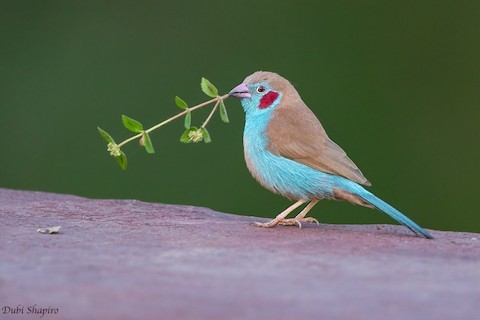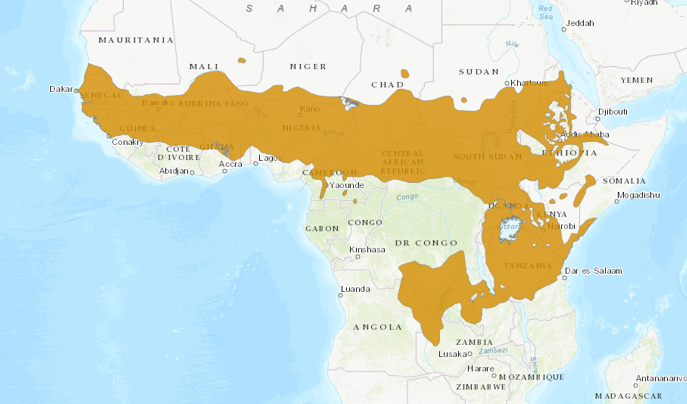Birdfinding.info ⇒ Generally common across much of its range. Areas where it is especially numerous include: coastal Senegal and Gambia; northern Ghana (e.g., Mole National Park); central Ethiopia; northern and western Uganda (Kidepo Valley and Murchison Falls National Parks); western Kenya; and northern Tanzania (Serengeti and Tanangire National Parks).
Red-cheeked Cordonbleu
Uraeginthus bengalus
Sahelian and central Africa, where it inhabits savannas, grasslands, brush, open woodlands, agricultural lands, and villages.
From southwestern Mauritania and Senegal east to northern Eritrea and south locally to northern Angola, Zambia, and southern Tanzania.
It is a popular cagebird so released or escaped individuals could occur nearly anywhere. Small, introduced populations were tenuously established in Hawaii on Oahu (around Diamond Head)in the 1970s and the Big Island (around Pu’u Wa’awa’a) from the 1970s to the 2000s, but both appear to have vanished.
Identification
Adult male is distinctive: bright-blue-and-pale-brown with bold red cheek patches.
The blue coloration is continuous from its face to its breast and flanks, then onto its rump and to the tip of its long, thin, pointed tail.
The shade of blue varies individually or seasonally, from a pale, powder-blue to deep turquoise or lazuli.
The bill and legs are dull-pink, with some blackish or dark-blue coloration on the edges of the bill.
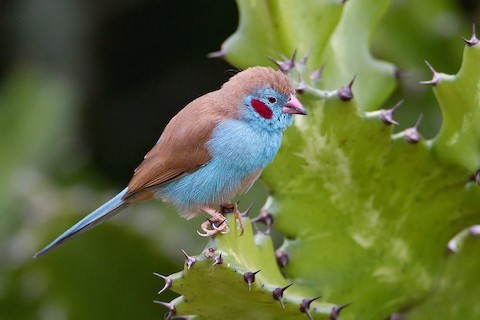
Red-cheeked Cordonbleu, male. (Mombasa, Kenya; January 20, 2014.) © Kevin Agar
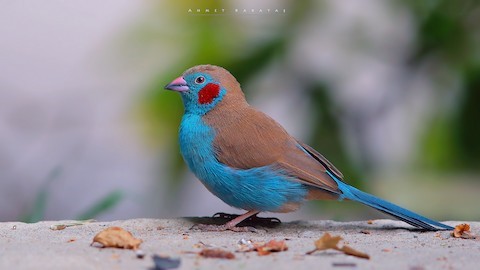
Red-cheeked Cordonbleu, male. (Ziway, Oromia, Ethiopia; February 14, 2019.) © Prof. Dr. Ahmet Karatash

Red-cheeked Cordonbleu, male showing vivid blue and red. (Eden House, Morendati, Kenya; April 16, 2018.) © Kevin Vande Vusse
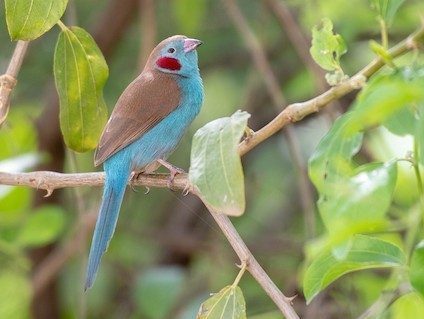
Red-cheeked Cordonbleu, male showing long, thin, blue, pointed tail. (Jemma River crossing, Amara, Ethiopia; August 3, 2018.) © Ana Paula Oxom
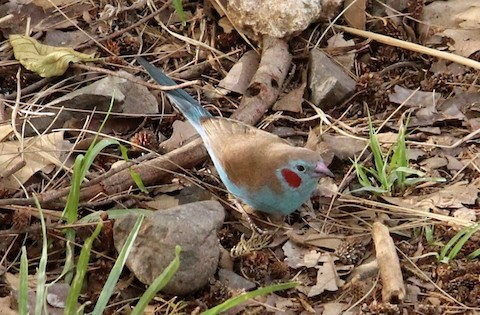
Red-cheeked Cordonbleu, male showing pale coloration overall. (Gondar, Amara, Ethiopia; June 12, 2015.) © Ben Chapman

Red-cheeked Cordonbleu, male. (Mole National Park, Ghana; Ferbuary 26, 2018.) © Eric Francois Roualet
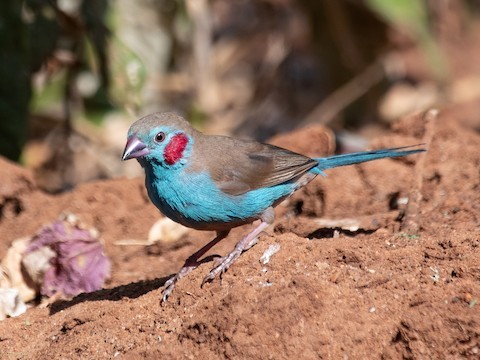
Red-cheeked Cordonbleu, male with mostly blackish bill. (Osunyai Wilderness Camp, Manyara-Tarangire National Park, Tanzania; June 30, 2019.) © T I

Red-cheeked Cordonbleu, male. (Tarangire National Park, Tanzania; February 3, 2014.) © Brooke Miller

Red-cheeked Cordonbleu, male, dorsal view. (Lake Nakuru National Park, Kenya; February 10, 2013.) © Nancy Barrett
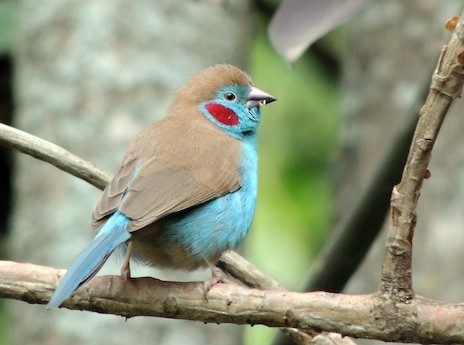
Red-cheeked Cordonbleu, male, dorsal view. (Wabe Shabelle, Lake Langan, Oromia, Ethiopia; August 7, 2015.) © Jeff Chapman
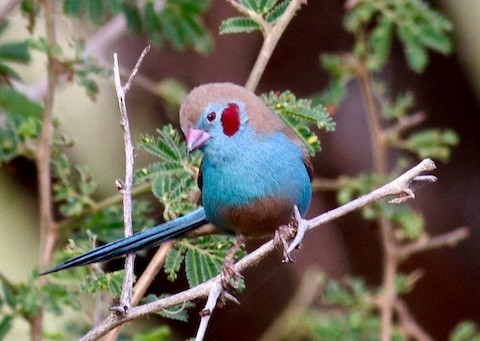
Red-cheeked Cordonbleu, male—note long, thin, blue, pointed tail cocked to the side. (Tarangire National Park, Tanzania; February 17, 2019.) © Charlie Nims
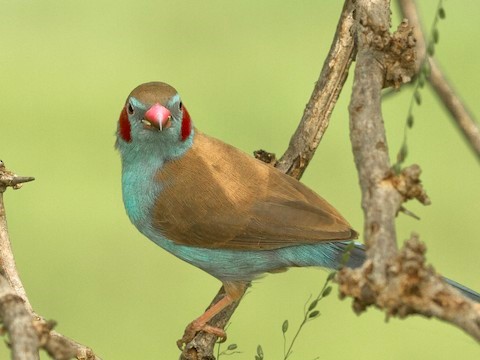
Red-cheeked Cordonbleu, male, side view. (Tarangire National Park, Tanzania; May 13, 2015.) © Phil Stouffer
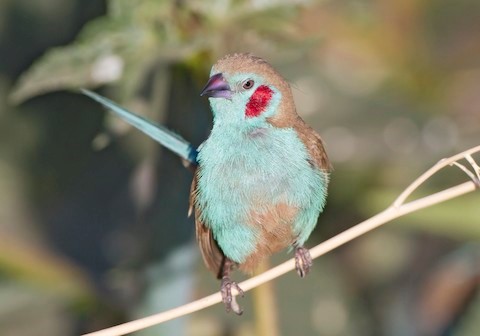
Red-cheeked Cordonbleu, male—note long, thin, blue, pointed tail cocked to the side. (Addis Ababa, Ethiopia; December 27, 2012.) © Marco Valentini
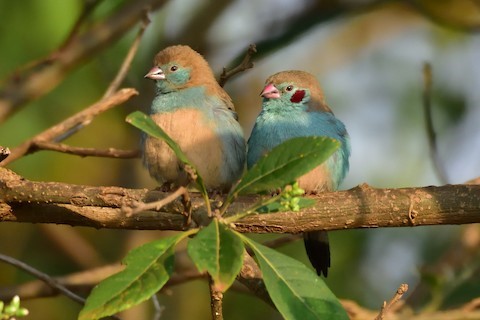
Red-cheeked Cordonbleu, female and male. (Fort Portal, Uganda; January 22, 2019.) © Santiago Caballero Carrera
Females lack the red cheeks and have more muted blue coloration, which is limited to the throat, chest, flanks, rump, and tail.
Females of the subspecies brunneigularis, which occurs in central Kenya, differ in having buffy-brown cheeks.
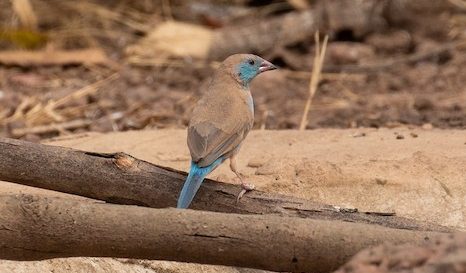
Red-cheeked Cordonbleu, female. (Tendaba, Gambia; January 6, 2019.) © James Kennedy

Red-cheeked Cordonbleu, female. (Nianing, Thiès, Senegal; April 19, 2011.) © Jean-François Garin
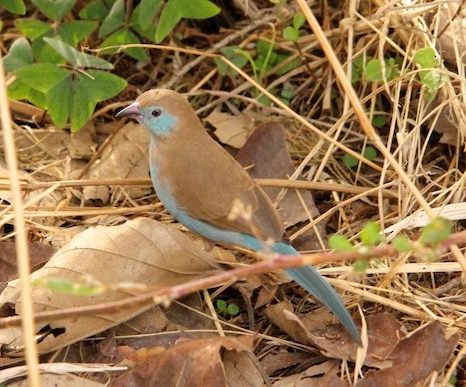
Red-cheeked Cordonbleu. (Gondar, Amara, Ethiopia; June 12, 2015.) © Ben Chapman

Red-cheeked Cordonbleu, female. (Bahir Dar, Amara, Ethiopia.) © John Thompson
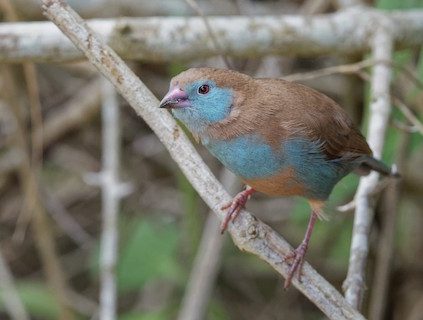
Red-cheeked Cordonbleu, female. (Lake Mburo National Park, Uganda; May 3, 2019.) © Vincent Wang
Immatures resemble females but generally have more limited blue coloration on the underparts, limited to the face, throat, and chest.

Red-cheeked Cordonbleu, immature. (Pointe des Almadies, Dakar, Senegal; January 12, 2018.) © Marie O’Neill
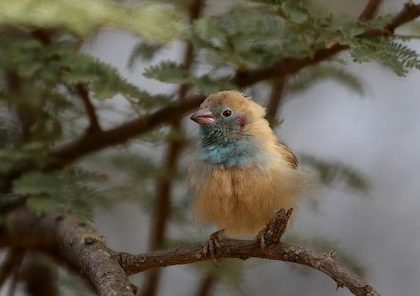
Red-cheeked Cordonbleu, immature male—note small red patch on cheek. (Richard Toll, Saint-Louis, Senegal; December 31, 2018.) © Jay McGowan
Cf. Southern and Blue-capped Cordonbleus. The Southern Cordonbleu overlaps in eastern Africa with both Red-cheeked and Blue-capped Cordonbleus—and all three occur together in Kenya and Tanzania. Males of the latter two have distinctive markings, but females can be confused with both male and female Southern Cordonbleu. All have approximately the same general appearance and coloration, including a blue face, throat, rump, and tail.
The two most consistent indicators are bill color and the extent of blue on the underparts:
Bill Color: Both sexes of Southern Cordonbleu have all-black bills; both sexes of Blue-capped Cordonbleus have all-pink bills; and both sexes of Red-cheeked Cordonbleu have mixed pink-and-black bills, although some individuals may have all-pink bills and some may appear mostly black. There is still some potential for confusion on this trait, however, because immatures of all species can have all-black bills.
Underparts: Male Southern Cordonbleu and females of the other two species all have blue that extends from the face across the throat, chest, and upper breast, and continues to flanks. On female Southern the blue extends only to the chest. There is still some potential for confusion on this trait, however, because immatures of all species can have approximately the same coloration as that of the female Southern.
Notes
Polytypic species consisting of four recognized subspecies.
References
BirdLife International. 2018. Uraeginthus bengalus. The IUCN Red List of Threatened Species 2018: e.T22719493A132129720. https://dx.doi.org/10.2305/IUCN.UK.2018-2.RLTS.T22719493A132129720.en. (Accessed April 5, 2020.)
Clement, P., A. Harris, and J. Davis. 1993. Finches and Sparrows: An Identification Guide. Princeton University Press, Princeton, N.J.
eBird. 2020. eBird: An online database of bird distribution and abundance. Cornell Lab of Ornithology, Ithaca, N.Y. http://www.ebird.org. (Accessed April 5, 2020.)
Payne, R. 2020. Red-cheeked Cordon-bleu (Uraeginthus bengalus). In Handbook of the Birds of the World Alive (J. del Hoyo, A. Elliott, J. Sargatal, D.A. Christie, and E. de Juana, eds.). Lynx Edicions, Barcelona. https://www.hbw.com/node/61126. (Accessed April 5, 2020.)
Pyle, R.L., and P. Pyle. 2017. The Birds of the Hawaiian Islands: Occurrence, History, Distribution, and Status. Version 2 (January 1, 2017). http://hbs.bishopmuseum.org/birds/rlp-monograph/. B.P. Bishop Museum, Honolulu, Hawaii.
van Perlo, B. 2002. Birds of Western and Central Africa. Princeton University Press, Princeton, N.J.
Xeno-Canto. 2020. Red-cheeked Cordon-bleu – Uraeginthus bengalus. https://www.xeno-canto.org/species/Uraeginthus-bengalus. (Accessed April 5, 2020.)
